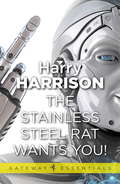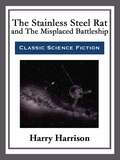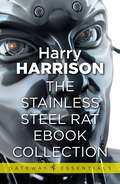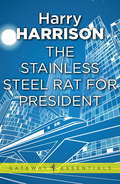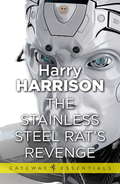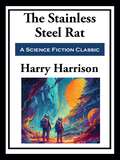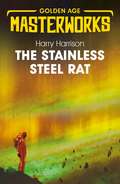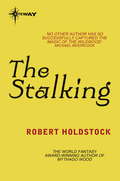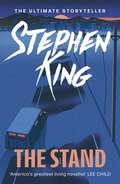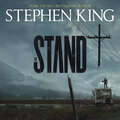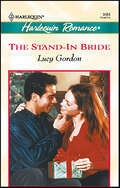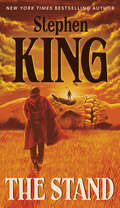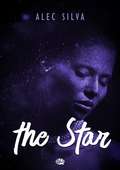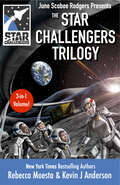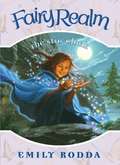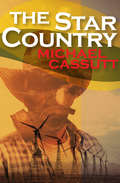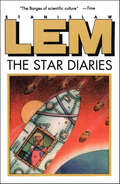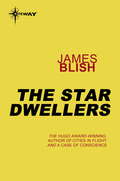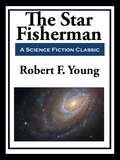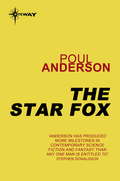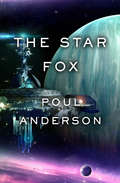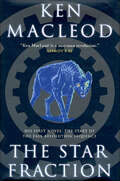- Table View
- List View
The Stainless Steel Rat Wants You!: The Stainless Steel Rat Book 4 (Gateway Essentials #86)
by Harry HarrisonSlippery Jim di Griz - the Stainless Steel Rat - is still recovering from his efforts to save his beloved Angelina from the notorious Interstellar Internal and External Revenue when he is called upon to perform the impossible. Saving the galaxy. But can he pull it off? The galaxy is being attacked by every kind of alien race - untold billions of tentacled, slimy, green, clawed mutations - and time is running out. Aided and abetted by his wife Angelina and his teenage sons, James and Bolivar, Jim infiltrates the nerve centre of the enemy council chambers. But he hasn't reckoned on the grey men and their commitment to a 'holy crusade' to destroy mankind - permanently!
The Stainless Steel Rat and The Misplaced Battleship
by Harry HarrisonIt's more than a little careless to lose a battleship, even in interstellar space. Enter Slippery Jim diGriz, better known as the Stainless Steel Rat, the fastest talking con-man in the galaxy. Jim will need to go undercover to find the missing battleship and make sure it doesn't fall into the wrong hands. A fast paced comical science fiction romp!
The Stainless Steel Rat eBook Collection (Gateway Essentials #301)
by Harry HarrisonThis collection comprises of the first six titles in Harry Harrison's brilliantly entertaining Stainless Steel Rat series, containing:A Stainless Steel Rat Is BornThe Stainless Steel Rat gets DraftedThe Stainless Steel Rat Sings the BluesThe Stainess Steel RatThe Stainless Steel Rat's RevengeThe Stainless Steel Rat Saves the World
The Stainless Steel Rat for President: The Stainless Steel Rat Book 5 (Gateway Essentials #84)
by Harry HarrisonYou can't keep a good rat down, not one as slippery as Jim di Griz, alias the Stainless Steel Rat. And you can't keep his nose out of trouble either.Jim and the lethal, luscious Angelina owe themselves a honeymoon and Paraiso-Aqui looks like the place. Settled long ago by voyagers from the southern continent of Earth (or Dirt as it was known) Paraiso is warm and easy. But all is not well in paradise. The serpentine tyrant General Julio Zapilote is about to sail back into office in another rigged election, and the chance to scupper him is just too good for Jim to miss. Corruption, bribery, graft and chicanery - for the Rat it's just like coming home.
The Stainless Steel Rat's Revenge: The Stainless Steel Rat Book 2 (Gateway Essentials #286)
by Harry HarrisonIt was totally impossible for Cliaand to wage interstellar war...but the crazy little planet was winning, whatever the odds. And there wasn't much the peaceful galaxy could do...except send Slippery Jim di Griz - the Stainless Steel Rat - to wage his own kind of guerrilla campaign against the grey men of Cliaand and their leader, the indomitable Kraj. But then the Rat was aided by a band of liberated Amazons and his own beloved, murderous Angelina...and they had to swing the odds in his favour.
The Stainless Steel Rat: A Stainless Steel Rat Is Born, The Stainless Steel Rat Gets Drafted, The Stainless Steel Rat Sings The Blues (Stainless Steel Rat Ser. #Bks. 6-8)
by Harry HarrisonHere&’s the original short story that first introduced us to Slippery Jim diGriz, better known as the Stainless Steel Rat! diGriz is charming, quick-witted, sophisticated, and a devious criminal mastermind. The Rat has just pulled off a successful and complex criminal operation, but the Special Corps is on his trail. Is this the end for the Stainless Steel Rat or just the beginning? Join Slippery Jim on this rollicking adventure.
The Stainless Steel Rat: The Stainless Steel Rat Book 1 (Golden Age Masterworks)
by Harry HarrisonIn the vastness of space, the crimes just get bigger and Slippery Jim diGriz, the Stainless Steel Rat, is the biggest criminal of them all. He can con humans, aliens and any number of robots time after time. Jim is so slippery that all the inter-galactic cops can do is make him one of their own.
The Stalking
by Robert HoldstockHe had been a quiet family man - devoted to his wife and children, happy in his home, happy in his work. It took just thirty minutes of shattering, obscene violence to transform him into a remorseless, avenging hunter of evil - a savage practitioner and enemy of the occult. For somewhere- somewhere beyond the normal and the good - they had his family. And Dan Brady had to find them.Against him was all the evil of the supernatural - powers he neither knew nor understood. Powers he himself would have to learn to use if he were to track down his family in the preternatural night.
The Stalking: Do You Fear What I Fear? / The Fright Before Christmas / Unholy Night / Stalking In A Winter Wonderland (Krewe of Hunters #29)
by Heather GrahamDark legends come to lifeWith the execution of a serial killer known as the Artiste, Cheyenne Donegal thinks a grim part of her past is finally put to rest. Her cousin had been the twisted killer’s final victim, and then-teenage Cheyenne was integral in bringing him to justice. That tragedy drove her to become an FBI agent. And now she’s back in Louisiana because someone is murdering young women in the same manner as the Artiste.Krewe of Hunters agent Andre Broussard has deep ties in New Orleans and Cajun country beyond. He knows that more than one monster has stalked the bayou. Has a deadly threat been resurrected, or does someone have a dark inspiration?With the life of a missing woman on the line, Cheyenne and Andre have to set aside their doubts about each other and work to discover the truth. The case is too close and too personal—but they can’t let it go, especially now that a ruthless killer has turned the tables and is hunting them.
The Stand
by Stephen KingStephen King's apocalyptic vision of a world blasted by virus and tangled in an elemental struggle between good and evil remains as riveting and eerily plausible as when it was first published.Soon to be a television series.'THE STAND is a masterpiece' (Guardian). Set in a virus-decimated US, King's thrilling American fantasy epic, is a Classic.First come the days of the virus. Then come the dreams.Dark dreams that warn of the coming of the dark man. The apostate of death, his worn-down boot heels tramping the night roads. The warlord of the charnel house and Prince of Evil.His time is at hand. His empire grows in the west and the Apocalypse looms.When a man crashes his car into a petrol station, he brings with him the foul corpses of his wife and daughter. He dies and it doesn't take long for the virus which killed him to spread across America and the world.
The Stand
by Stephen KingFirst came the days of the plague. Then came the dreams.Dark dreams that warned of the coming of the dark man. The apostate of death, his worn-down boot heels tramping the night roads. The warlord of the charnel house and Prince of Evil.His time is at hand. His empire grows in the west and the Apocalypse looms.(P)2012 Random House Audio
The Stand-In Bride
by Lucy GordonDon Sebastian Santiago's fiancée may have publicly betrayed him at the town's Christmas celebrations--but that doesn't mean his wedding is off. He blames his fiancée's tutor, Maggie, for what has happened--so it's Maggie who will be his stand-in bride!In this emotionally intense novel from award-winning author Lucy Gordon, there's power, pride and passion. Read on to find out how Maggie must confront her troubled past before she and Sebastian can learn to trust--and love--each other....
The Stand: American Nightmares (Premiere Ser.)
by Stephen King#1 BESTSELLER • Stephen King&’s apocalyptic vision of a world blasted by plague and tangled in an elemental struggle between good and evil remains as riveting—and eerily plausible—as when it was first published.One of The Atlantic&’s Great American Novels of the Past 100 Years! This edition includes all of the new and restored material first published in The Stand: The Complete and Uncut Edition.A patient escapes from a biological testing facility, unknowingly carrying a deadly weapon: a mutated strain of super-flu that will wipe out 99 percent of the world&’s population within a few weeks. Those who remain are scared, bewildered, and in need of a leader. Two emerge—Mother Abagail, the benevolent 108-year-old woman who urges them to build a peaceful community in Boulder, Colorado; and Randall Flagg, the nefarious &“Dark Man,&” who delights in chaos and violence. As the dark man and the peaceful woman gather power, the survivors will have to choose between them—and ultimately decide the fate of all humanity."A master storyteller."—Los Angeles Times
The Star
by Alec Silva Maria NevesIn a world where wolves are enemies of the sun and moon, Ulmer was a huge wolf who lived alone in a cave. One day, upon receiving the unusual visit of a girl in search of an entity known as Star, whose magical jars were lost in the sky and found on earth by the human, he leaves on a suicide mission. Facing a violent glacial storm and a horde of bloodthirsty bears, the unlikely duo will go through the final stage of a long epic journey.
The Star Challengers Trilogy: Moonbase Crisis, Space Station Crisis, Asteroid Crisis
by Kevin J. Anderson Rebecca MoestaIncludes all three books: Moonbase Crisis, Space Station Crisis, and Asteroid Crisis. After an exhilarating space simulation field trip at the local Challenger Center, a group of students are hand-picked by the mysterious Commander Zota for special adventures: to travel to the future to save Earth!
The Star Cloak (Fairy Realm #7)
by Emily RoddaWhen Giff the elf comes asking for Jessie's help, she returns to the Realm on a quest to have the fairies mend the Star Cloak in time for Wish Night.
The Star Country
by Michael CassuttAn &“agreeable debut novel&” of a fragmented US and first alien contact from the Twilight Zone and Z Nation TV writer (Kirkus Reviews). In the near future, war has torn the United States apart. Small communities barely scrape by amidst climate change and economic collapse. Powerful nation-states struggle over whatever resources remain--technology in California, money in Chicago, oil in Texas. Some small hope has arrived in the form of the Hocq, a group of aliens on a mission to bring their advanced knowledge to Earth. But, as hostile governments across the globe vie for that knowledge, a Hocq named Harrek defects into outlaw territory. Diplomacy seems to have failed, and he can&’t allow the wrong nation to gain such a huge advantage over the others. Now it&’s up to Lisa Marquez, the human who helped Harrek escape, and Jeremy Clayton, a poor outland farmer, to keep the alien safe from the military and outlaws. The clock is counting down, and Harrek needs to get the Genesis File into the right hands before he gets found by the humans...or the other Hocq. In Michael Cassutt's first novel, the author takes standard SF story situations--post-holocaust tribal human struggles, first alien contact--blends them together and and brings his own uniquely original spin to a tried-and-true setting.
The Star Diaries: Further Reminiscences of Ijon Tichy (From the Memoirs of Ijon Tichy)
by Stanislaw LemIjon Tichy, Lem's Candide of the Cosmos, encounters bizarre civilizations and creatures in space that serve to satirize science, the rational mind, theology, and other icons of human pride. Line drawings by the Author. Translated by Michael Kandel. A Helen and Kurt Wolff Book
The Star Dwellers
by James BlishThe inhabitants of Terra could not believe these beings were sentient and intelligent, but the inhabitants of Terra needed to establish contact with them. By chance, the role Jack Loftus was to play in this became crucial: if he were successful, it would open a new era in interstellar relations, if he were not . . .
The Star Dwellers: Heart Stars Book 1 (HEART STARS)
by James BlishThe inhabitants of Terra nicknamed them "Angels". They were exquisitely beautiful, these shimmering, fiery creatures , highly intelligent and playful. Yet they were awesome, too, considering that the youngest were four million years old, and the oldest had probably participated in the First Cause, which had given birth to the whole universe. To young space cadet Jack Loftus fell the overwhelming responsibility of negotiating a treaty with them - a treaty which could mean the life or death of earth and mankind.
The Star Fisherman
by Robert F. YoungMen have fought and died, sung and cried, stolen and lied for love. Christopher Stark did all of these—and more. Over his life loomed two gigantic images: that of the beautiful Priscilla, and that of the mysterious fisher-figure in the reaches of space. Robert F. Young was a Hugo nominated author known for his lyrical and sentimental prose. His work appeared in Amazing Stories, Fantastic Stories, Startling Stories, Playboy, The Saturday Evening Post, Collier&’s, Galaxy Magazine, and Analog Science Fact & Fiction.
The Star Fox
by Poul AndersonThe Cynbe sang: "Back to your planet must you be cast! Back to your caves and your dust! STARWARD FROM EARTH The Aliens were as powerful as they were beautiful, and Earth had faltered before them. Now the Time-deep Aleriona were tightening their silvery grip on the universe, and all that stood between humankind and extinction was a band of guerrillas on a fire-stormed planet--and a legend called Star Fox. . . .
The Star Fox
by Poul AndersonEarthmen and Aleriona have met in space and neither side can afford to let the other get too strong. The Aleriona have captured the human outpost, New Europe, and claim that all the inhabitants were killed. The World Federation on Earth seems committed to peace at any price, but there are those, and ex-navy Captain Gunnar Heim is one of them, who know that appeasement will only lead to further Alerion encroachment, and he passionately believes that there must be a showdown now, before it is too late.Heim and his crew of volunteers take off from Earth in the Star Fox and start to fit out for their hit-and-run battle.
The Star Fox
by Poul AndersonAn intergalactic privateer resolves to rescue a human space colony taken captive by alien aggressors An outpost located at the edge of the galaxy, New Europe has been overrun by the Aleriona, a hostile alien race that resents humanity's incursion into deep space. Fearing a wider war, the World Federation on Earth is hesitant to respond to the outrage, especially since the invaders claim the colonists have already been killed. But ex-navy captain Gunnar Heim refuses to believe there's no one left--and he's convinced that what happened to New Europe is only the beginning of the Aleriona's intergalactic aggression. The cowardly Terran government refusing to act, Gunnar takes matters into his own hands. Assembling a crew of able volunteers, he prepares to pilot the spaceship Star Fox and confront a relentless foe light years from Earth. Nominated for the Nebula Award, The Star Fox is a magnificent space opera adventure that confirms Poul Anderson's standing as one of the premier science fiction authors of the twentieth century--not only a contemporary of such luminaries as Asimov, Heinlein, Herbert, and Clarke, but every bit their equal.
The Star Fraction (The Fall Revolution Sequence)
by Ken MacLeodWINNER OF THE PROMETHEUS AWARDBritain in the 21st century is a Balkanized mess. Moh Kohn is a security mercenary unaware that he holds the key to information which could change the world. Janis Taine is a scientist who needs Mohs help. And a rogue computer program is guiding events to a breathtaking conclusion.At the Publisher's request, this title is being sold without Digital Rights Management Software (DRM) applied.
